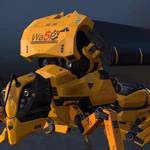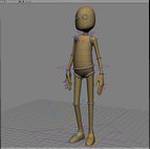I recently started to rebuild a dandelion image I did some years ago in LW. Everything so far is based on ICE. I managed to solve some aspects of the project in terms of being able to animate the whole thing, but there are still some areas which need refinement and ideas to solve certain issues.
This is the first test in order to ensure that the fibres stay attached to the end of the seeds. The fibres also get deformed by forces which result in the movement of the seeds.
Dandelion R&D
Dandelion R&D
Second video with a test for a global wind force effecting all plants on the final meadow. The stems are strands with about 10 segments. The cylinder as a placeholder for the flower is on a second point cloud which tracks the movement of the final segment of the stem strand.
Dandelion R&D
In this video I do have a rotational force applied to the stems which is supposed to rotate the seeds in such a fashion that the fibrous end is pointing upwards and the thick ending of the seed is pointing downwards.
This is kind of experimental. There also seems to be a kind of leak, as the swinging stops even without a damping force applied after a few seconds. The wind force is currently not included in the swinging movement.
I wonder whether strands would make this force easier to manage. Right now this force is based on the angle of the seed and the gravity, resulting in a force tangentially to the seed direction.
Dandelion R&D
Does anybody has an advice for checking intercollision of the seeds and collision between the seeds and the flower head? I do own Momentum 3, but never used it so far. So I do have no idea whether this would be the way to go or if some other kind of rigid body simulation if suitable too.
Also, how would this collision simulation go together with the other forces currently applied?
Also, how would this collision simulation go together with the other forces currently applied?
Re: Dandelion R&D
you could try neighbouring forces like Alan does for his baloons... a lower force might get you something a bit more flexible / less rigid.
dont know how would you couple that with the strands in the end though... but it is probably doable
Gustavo Eggert Boehs
Blog: http://www.gustavoeb.com.br/
Blog: http://www.gustavoeb.com.br/
Re: Dandelion R&D
Oh! Great! The video is finaly up. Just saw the teaser some time ago.
Thanks! I'll take a look. Wow. 55min.....
Thanks! I'll take a look. Wow. 55min.....
Re: Dandelion R&D
lol... zap through until you find where he uses neighbouring forces...
basically he just scale the forces according to the size and all. nothing fancy but works wonders
basically he just scale the forces according to the size and all. nothing fancy but works wonders
Gustavo Eggert Boehs
Blog: http://www.gustavoeb.com.br/
Blog: http://www.gustavoeb.com.br/
Re: Dandelion R&D
I just checked one of the example scenes in the SI folder "Strand dynamics hair". I got rid of the collision nodes and another one which goes in the iteration node as well, reduced the strand segments to one. Also the damp force is disabled. So it's only gravity working on the strands.
Everything looks like expected: Each strand swings like a pendulum, but not for very much longer. After 20-30 pendulum movements each strand comes to a stop. For my current purpose this might be good enough, but to understand what's going on under the hood: Where's the energy leak? Actually it should continue to swing till the end of days (at least till I switch off the computer). Anybody an idea whether it's the verlet integration or the length constrain?
Cheers!
Everything looks like expected: Each strand swings like a pendulum, but not for very much longer. After 20-30 pendulum movements each strand comes to a stop. For my current purpose this might be good enough, but to understand what's going on under the hood: Where's the energy leak? Actually it should continue to swing till the end of days (at least till I switch off the computer). Anybody an idea whether it's the verlet integration or the length constrain?
Cheers!
Re: Dandelion R&D
I'd say, don't confuse yourself with comparison to real world, in case of verlet/spring stuff. It's like taking the Phong specular as reflection model. It's just similar to some point, that's all.Pancho wrote: Everything looks like expected: Each strand swings like a pendulum, but not for very much longer. After 20-30 pendulum movements each strand comes to a stop. For my current purpose this might be good enough, but to understand what's going on under the hood: Where's the energy leak? Actually it should continue to swing till the end of days (at least till I switch off the computer). Anybody an idea whether it's the verlet integration or the length constrain?
Cheers!
There's good (and short
About collision (at least, 'test collision with surface' node) - strand segment ( or point) is left to penetrate into object, closest location on surface is tested. Point normal of surface is tested, compared with direction ( using dot product) - if it's considered inside, strand segment is just pushed back to closest location. This means, in case of fast movement, strand segment can pass through the object - or in case of less fast, it can be pushed to opposite side.
Who is online
Users browsing this forum: No registered users and 85 guests

































































